2023届高三英语二轮复习---Grammar现在进行时表将来教学课件(共20张)
文档属性
| 名称 | 2023届高三英语二轮复习---Grammar现在进行时表将来教学课件(共20张) | 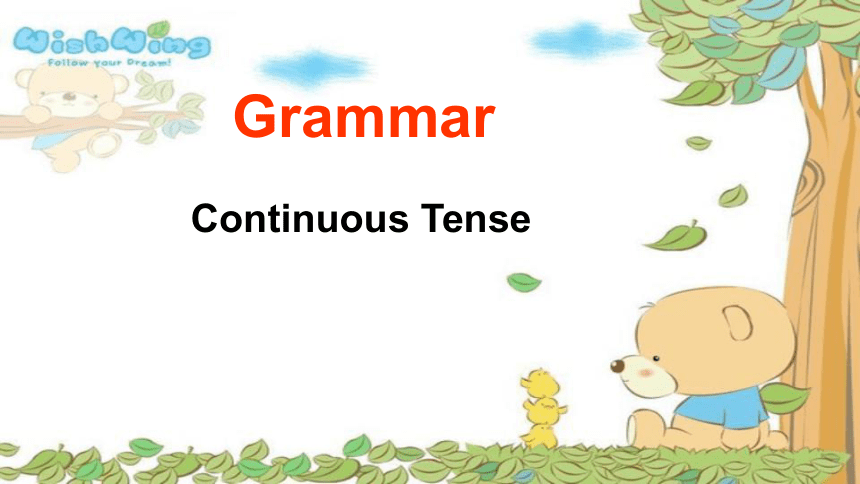 | |
| 格式 | pptx | ||
| 文件大小 | 878.4KB | ||
| 资源类型 | 教案 | ||
| 版本资源 | 人教版(2019) | ||
| 科目 | 英语 | ||
| 更新时间 | 2024-12-03 20:16:58 | ||
图片预览


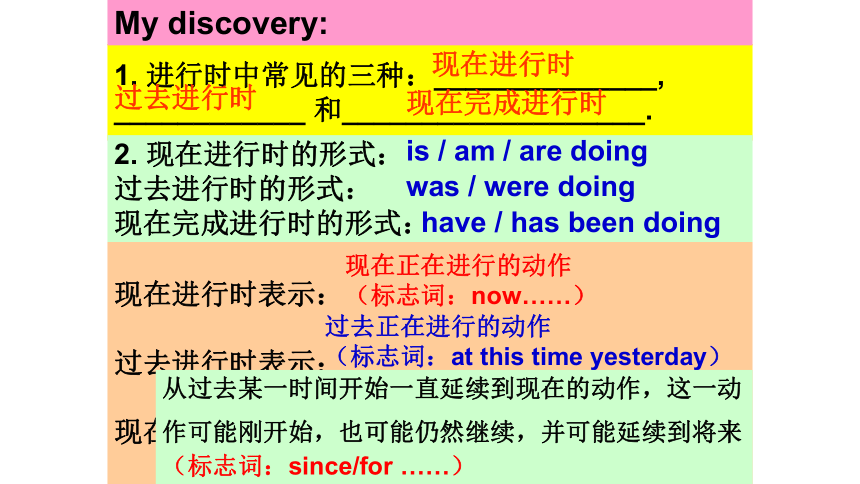
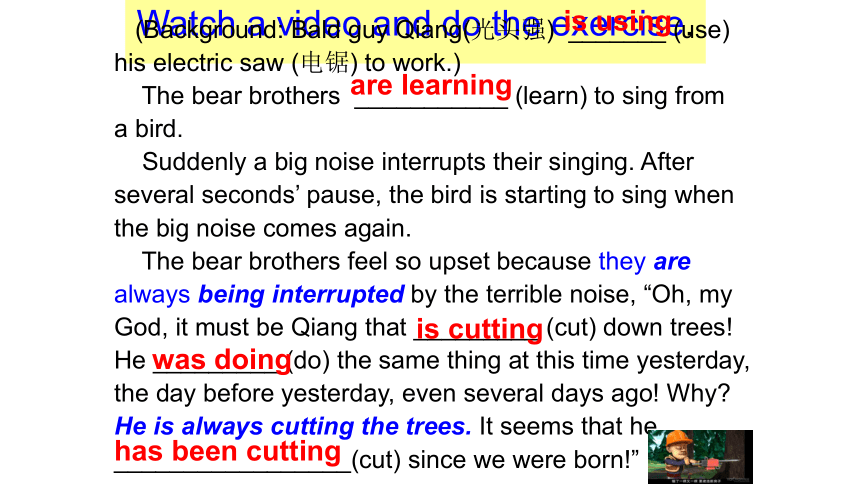

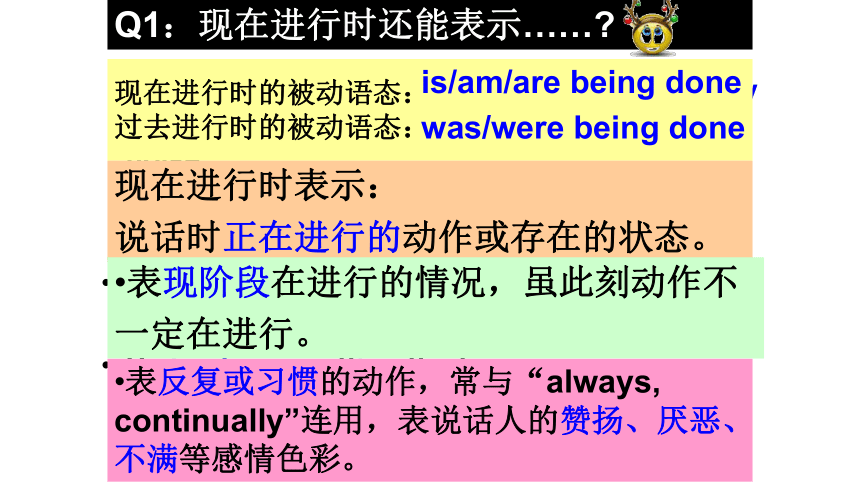
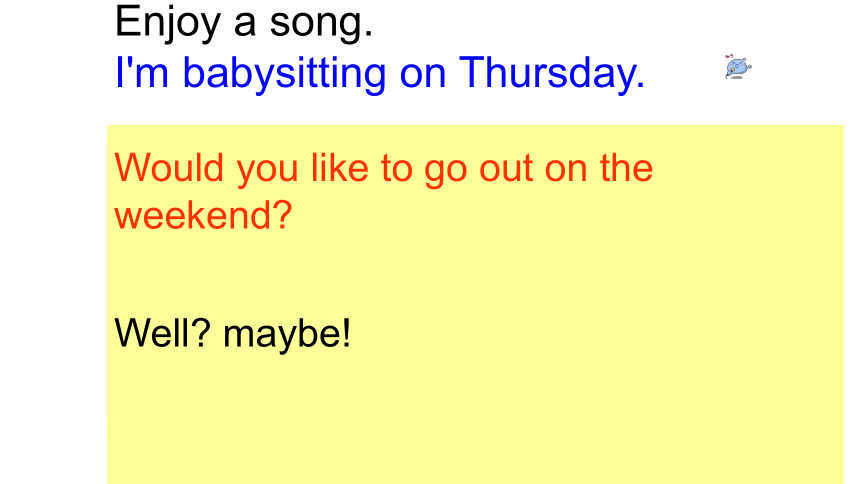
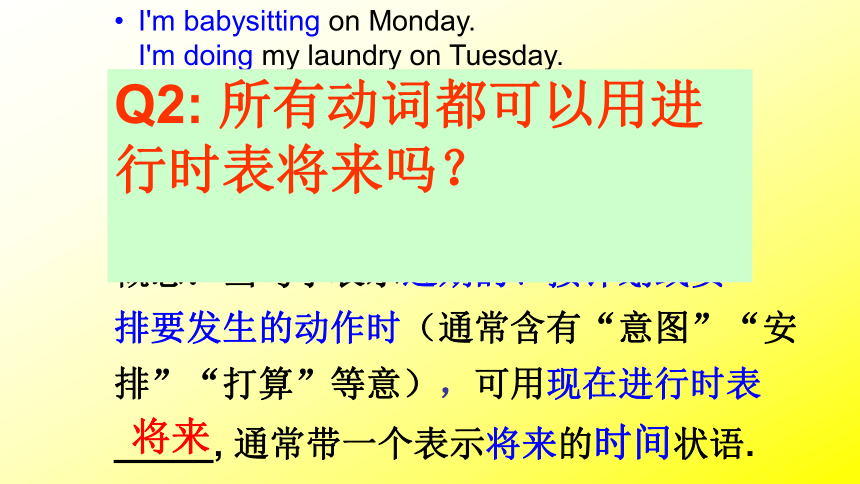
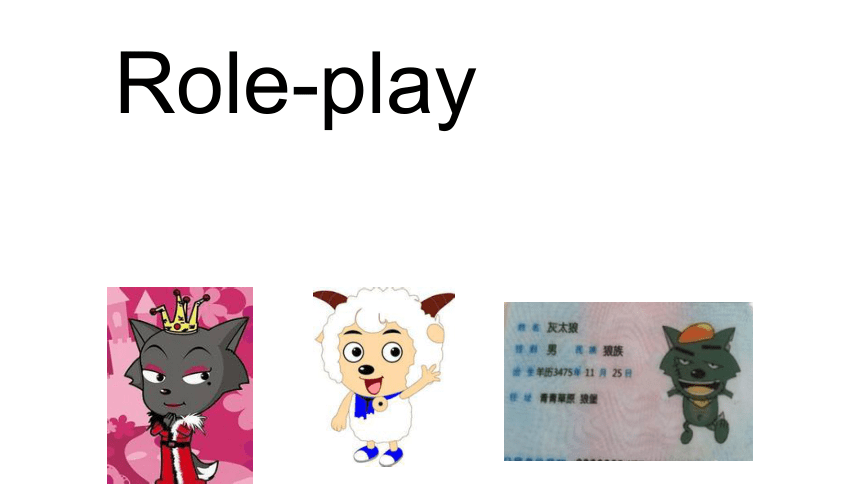
文档简介
(共20张PPT)
Grammar
Continuous Tense
We can well remember in the cartoon, the cat Tom is always chasing after the mouse Jerry, but rarely succeeds in catching it.
Actually sometimes they are friends. Oh, look, they are dancing together.
However, a lot of times they are enemies. You see, Tom now is running after Jimmy.
And do you know Tom was also running after Jimmy at this time yesterday!
Therefore, it seems that Tom has always been running after Jimmy.
1. 进行时中常见的三种:______________,
____________ 和___________________.
My discovery:
2. 现在进行时的形式:
过去进行时的形式:
现在完成进行时的形式:
现在完成进行时
现在进行时
过去进行时
is / am / are doing
was / were doing
have / has been doing
现在进行时表示:
过去进行时表示:
现在完成进行时表示:
现在正在进行的动作
(标志词:now……)
过去正在进行的动作
(标志词:at this time yesterday)
从过去某一时间开始一直延续到现在的动作,这一动作可能刚开始,也可能仍然继续,并可能延续到将来
(标志词:since/for ……)
Watch a video and do the exercise.
(Background: Bald guy Qiang() _______ (use)
his electric saw (电锯) to work.)
The bear brothers ___________ (learn) to sing from
a bird.
Suddenly a big noise interrupts their singing. After
several seconds’ pause, the bird is starting to sing when
the big noise comes again.
The bear brothers feel so upset because they are
always being interrupted by the terrible noise, “Oh, my
God, it must be Qiang that _________ (cut) down trees!
He _________ (do) the same thing at this time yesterday,
the day before yesterday, even several days ago! Why
He is always cutting the trees. It seems that he
_________________(cut) since we were born!”
is using
are learning
is cutting
was doing
has been cutting
My summary1: 动词的ing形式
learning
doing
using
cutting
少数几个以-ie结尾的单音节动词,把ie变成y再加-ing,如:恐怖三人行
dying 死;tying 系,捆绑;lying 躺或说谎.
以不发音的e结尾(重读相对开音节)的动词,去掉e再加ing.
直接加上-ing
以重读闭音节结尾的动词,末尾只有一个辅音字母时,先双写这个辅音字母再加上-ing.
当e前面是元音或去掉e引起发音变化时,e要保留:agree see
agreeing
seeing
My summary2
1. The bear brothers feel so upset because they are always being interrupted by the terrible noise.
2. Qiang is using his electric saw to work.
Qiang is cutting the tree recently.
He is always cutting the trees.
现在进行时的被动语态:
过去进行时的被动语态:
is/am/are being done
was/were being done
现在进行时表示:
说话时正在进行的动作或存在的状态。
表现阶段在进行的情况,虽此刻动作不
一定在进行。
表反复或习惯的动作,常与“always, continually”连用,表说话人的赞扬、厌恶、不满等感彩。
Q1:现在进行时还能表示……
Enjoy a song.
I'm babysitting on Thursday.
Would you like to go out on Monday
No, sorry, I can’t.
Why not
I‘m babysitting (照料小孩)on Monday.
Would you like to go out onTuesday
No, sorry, I can’t.
Why not
I‘m doing my laundry(洗衣服) on Tuesday.
Would you like to go out on
Wednesday
No, sorry, I can’t.
Why not
I'm working overtime on Wednesday.
Would you like to go out on Thursday
No, sorry, I can’t.
Why not
I'm working out on Thursday.
Would you like to go out on Friday
No, sorry, I can’t.
Why not
I‘m visiting relatives(拜访亲戚)
on Friday.
Would you like to go out on the weekend
Well maybe!
I'm babysitting on Monday.
I'm doing my laundry on Tuesday.
I'm working overtime on Wednesday.
I'm working out on Thursday.
I'm visiting relatives on Friday.
My summary3:
概念:当句子表示近期的、按计划或安
排要发生的动作时(通常含有“意图”“安
排”“打算”等意),可用现在进行时表
_____, 通常带一个表示将来的时间状语.
Q2: 所有动词都可以用进行时表将来吗?
将来
Role-play
Big big wolf, go to catch the sheep!
Ok! My dear wife, I’m leaving for the sheep village at once!
Hurry up! Are you walking there
Don’t worry, my dear wife, I’m flying there with your pan.
Haha! Little sheep, I’m coming!
Oh my god, the big big wolf is arriving here !
2. 表示交通方式、行程安排的动词, 例如_____________ ride, drive, take (a bus, a boat, a taxi) 等的现在进行时也经常用于表示将来。
leave, come, arrive
My summary4:
1. 通常是短时间动作,限于少数表趋向性或位置移动的动词,常见的有:__________________
do, go, work, see off, wait, travel, visit, meet .
walk, fly,
进行时与高考之听说
三问:
1. 灰太狼正在干什么?
2. 灰太狼正在抓羊还是正在被羊追呢?
3. 灰太狼不会再来了,是吗?
What is Big big wolf doing now
Is Big big wolf chasing after the sheep or
being run after by sheep
Big big wolf is not coming back, is it
I’m writing to ……
I’m looking forward to hearing from you.
I have been learning English since primary school but I still have trouble in it. Therefore, I’d like to ask for your help.
Recently, I am trying to / have been trying to recite English words, but I can not remember, which upsets me a lot.
进行时与高考之写作
Q3: When will we use continuous tense in writing
1. 进行时中常见的三种:______________,
____________ 和___________________.
Conclusion
2. 现在进行时的形式:
过去进行时的形式:
现在完成进行时的形式:
现在完成进行时
现在进行时
过去进行时
is / am / are doing
was / were doing
have / has been doing
现在进行时的被动语态:
过去进行时的被动语态:
is/am/are being done
was/were being done
否定?
not
Conclusion
现在进行时表示:
过去进行时表示:
现在完成进行时表示:
现在正在进行的动作
(标志词:now……)
过去正在进行的动作
(标志词:at this time yesterday)
从过去某一时间开始一直延续到现在的动作,这一动作可能刚开始,也可能仍然继续,并可能延续到将来
(标志词:since/for ……)
表现阶段在进行的情况,虽此刻动作不一定在进行。
表反复或习惯的动作,常与“always, continually”连用,表说话人的赞扬、厌恶、不满等感彩。
动词的ing形式
5. 少数几个以-ie结尾的单音节动词,把ie变成y再加-ing,如:恐怖三人行
dying 死;tying 系,捆绑;lying 躺或说谎.
3. 当e前面是元音或去掉e引起发音变化时,e要保留:agreeing 同意 seeing
4. 以重读闭音节结尾的动词,末尾只有一个辅音字母时,先双写这个辅音字母再加上-ing.
1. 直接加上-ing
2. 以不发音的e结尾(重读相对开音节)的动
词,去掉e再加ing.
Homework
Finish the exercise part1, 2, and 3 on page 215 of your reference book《名师小课堂》 .
Grammar
Continuous Tense
We can well remember in the cartoon, the cat Tom is always chasing after the mouse Jerry, but rarely succeeds in catching it.
Actually sometimes they are friends. Oh, look, they are dancing together.
However, a lot of times they are enemies. You see, Tom now is running after Jimmy.
And do you know Tom was also running after Jimmy at this time yesterday!
Therefore, it seems that Tom has always been running after Jimmy.
1. 进行时中常见的三种:______________,
____________ 和___________________.
My discovery:
2. 现在进行时的形式:
过去进行时的形式:
现在完成进行时的形式:
现在完成进行时
现在进行时
过去进行时
is / am / are doing
was / were doing
have / has been doing
现在进行时表示:
过去进行时表示:
现在完成进行时表示:
现在正在进行的动作
(标志词:now……)
过去正在进行的动作
(标志词:at this time yesterday)
从过去某一时间开始一直延续到现在的动作,这一动作可能刚开始,也可能仍然继续,并可能延续到将来
(标志词:since/for ……)
Watch a video and do the exercise.
(Background: Bald guy Qiang() _______ (use)
his electric saw (电锯) to work.)
The bear brothers ___________ (learn) to sing from
a bird.
Suddenly a big noise interrupts their singing. After
several seconds’ pause, the bird is starting to sing when
the big noise comes again.
The bear brothers feel so upset because they are
always being interrupted by the terrible noise, “Oh, my
God, it must be Qiang that _________ (cut) down trees!
He _________ (do) the same thing at this time yesterday,
the day before yesterday, even several days ago! Why
He is always cutting the trees. It seems that he
_________________(cut) since we were born!”
is using
are learning
is cutting
was doing
has been cutting
My summary1: 动词的ing形式
learning
doing
using
cutting
少数几个以-ie结尾的单音节动词,把ie变成y再加-ing,如:恐怖三人行
dying 死;tying 系,捆绑;lying 躺或说谎.
以不发音的e结尾(重读相对开音节)的动词,去掉e再加ing.
直接加上-ing
以重读闭音节结尾的动词,末尾只有一个辅音字母时,先双写这个辅音字母再加上-ing.
当e前面是元音或去掉e引起发音变化时,e要保留:agree see
agreeing
seeing
My summary2
1. The bear brothers feel so upset because they are always being interrupted by the terrible noise.
2. Qiang is using his electric saw to work.
Qiang is cutting the tree recently.
He is always cutting the trees.
现在进行时的被动语态:
过去进行时的被动语态:
is/am/are being done
was/were being done
现在进行时表示:
说话时正在进行的动作或存在的状态。
表现阶段在进行的情况,虽此刻动作不
一定在进行。
表反复或习惯的动作,常与“always, continually”连用,表说话人的赞扬、厌恶、不满等感彩。
Q1:现在进行时还能表示……
Enjoy a song.
I'm babysitting on Thursday.
Would you like to go out on Monday
No, sorry, I can’t.
Why not
I‘m babysitting (照料小孩)on Monday.
Would you like to go out onTuesday
No, sorry, I can’t.
Why not
I‘m doing my laundry(洗衣服) on Tuesday.
Would you like to go out on
Wednesday
No, sorry, I can’t.
Why not
I'm working overtime on Wednesday.
Would you like to go out on Thursday
No, sorry, I can’t.
Why not
I'm working out on Thursday.
Would you like to go out on Friday
No, sorry, I can’t.
Why not
I‘m visiting relatives(拜访亲戚)
on Friday.
Would you like to go out on the weekend
Well maybe!
I'm babysitting on Monday.
I'm doing my laundry on Tuesday.
I'm working overtime on Wednesday.
I'm working out on Thursday.
I'm visiting relatives on Friday.
My summary3:
概念:当句子表示近期的、按计划或安
排要发生的动作时(通常含有“意图”“安
排”“打算”等意),可用现在进行时表
_____, 通常带一个表示将来的时间状语.
Q2: 所有动词都可以用进行时表将来吗?
将来
Role-play
Big big wolf, go to catch the sheep!
Ok! My dear wife, I’m leaving for the sheep village at once!
Hurry up! Are you walking there
Don’t worry, my dear wife, I’m flying there with your pan.
Haha! Little sheep, I’m coming!
Oh my god, the big big wolf is arriving here !
2. 表示交通方式、行程安排的动词, 例如_____________ ride, drive, take (a bus, a boat, a taxi) 等的现在进行时也经常用于表示将来。
leave, come, arrive
My summary4:
1. 通常是短时间动作,限于少数表趋向性或位置移动的动词,常见的有:__________________
do, go, work, see off, wait, travel, visit, meet .
walk, fly,
进行时与高考之听说
三问:
1. 灰太狼正在干什么?
2. 灰太狼正在抓羊还是正在被羊追呢?
3. 灰太狼不会再来了,是吗?
What is Big big wolf doing now
Is Big big wolf chasing after the sheep or
being run after by sheep
Big big wolf is not coming back, is it
I’m writing to ……
I’m looking forward to hearing from you.
I have been learning English since primary school but I still have trouble in it. Therefore, I’d like to ask for your help.
Recently, I am trying to / have been trying to recite English words, but I can not remember, which upsets me a lot.
进行时与高考之写作
Q3: When will we use continuous tense in writing
1. 进行时中常见的三种:______________,
____________ 和___________________.
Conclusion
2. 现在进行时的形式:
过去进行时的形式:
现在完成进行时的形式:
现在完成进行时
现在进行时
过去进行时
is / am / are doing
was / were doing
have / has been doing
现在进行时的被动语态:
过去进行时的被动语态:
is/am/are being done
was/were being done
否定?
not
Conclusion
现在进行时表示:
过去进行时表示:
现在完成进行时表示:
现在正在进行的动作
(标志词:now……)
过去正在进行的动作
(标志词:at this time yesterday)
从过去某一时间开始一直延续到现在的动作,这一动作可能刚开始,也可能仍然继续,并可能延续到将来
(标志词:since/for ……)
表现阶段在进行的情况,虽此刻动作不一定在进行。
表反复或习惯的动作,常与“always, continually”连用,表说话人的赞扬、厌恶、不满等感彩。
动词的ing形式
5. 少数几个以-ie结尾的单音节动词,把ie变成y再加-ing,如:恐怖三人行
dying 死;tying 系,捆绑;lying 躺或说谎.
3. 当e前面是元音或去掉e引起发音变化时,e要保留:agreeing 同意 seeing
4. 以重读闭音节结尾的动词,末尾只有一个辅音字母时,先双写这个辅音字母再加上-ing.
1. 直接加上-ing
2. 以不发音的e结尾(重读相对开音节)的动
词,去掉e再加ing.
Homework
Finish the exercise part1, 2, and 3 on page 215 of your reference book《名师小课堂》 .
